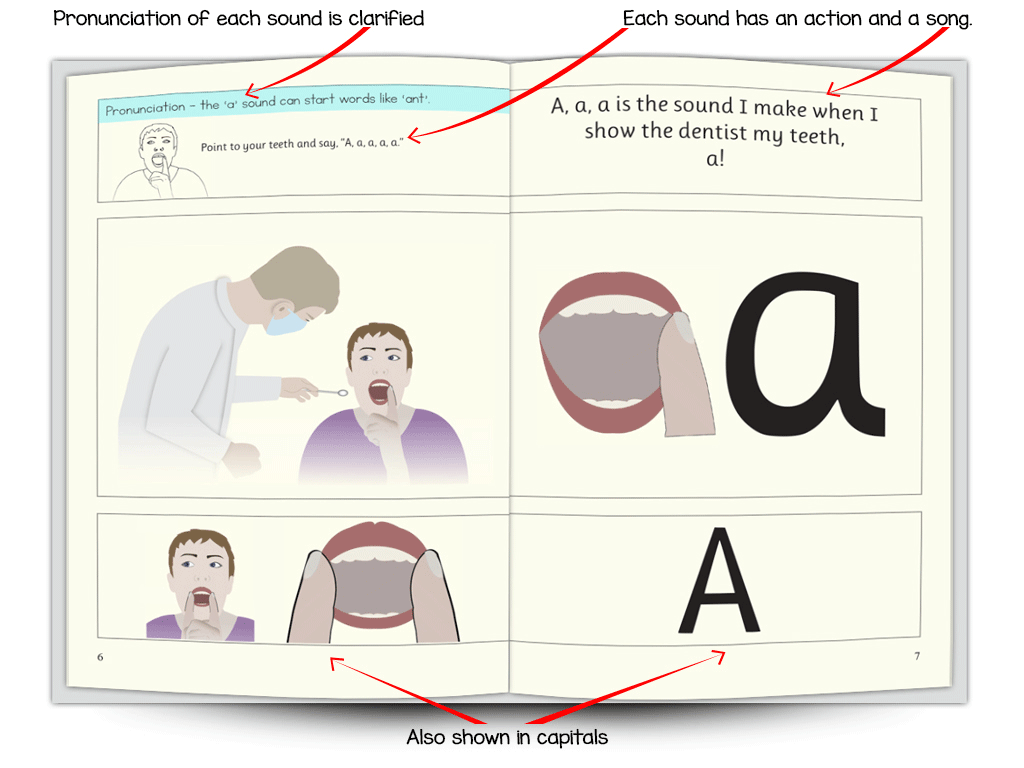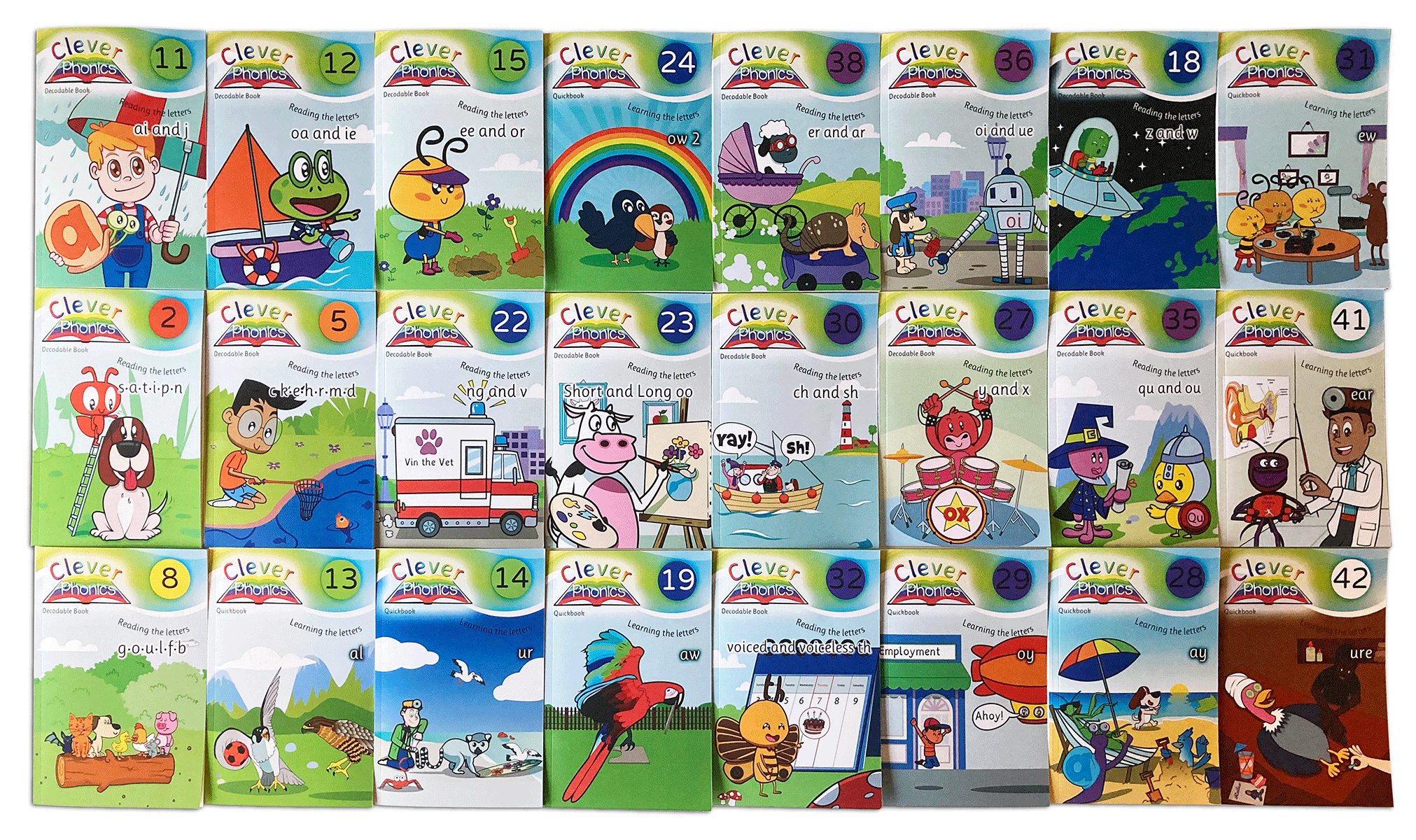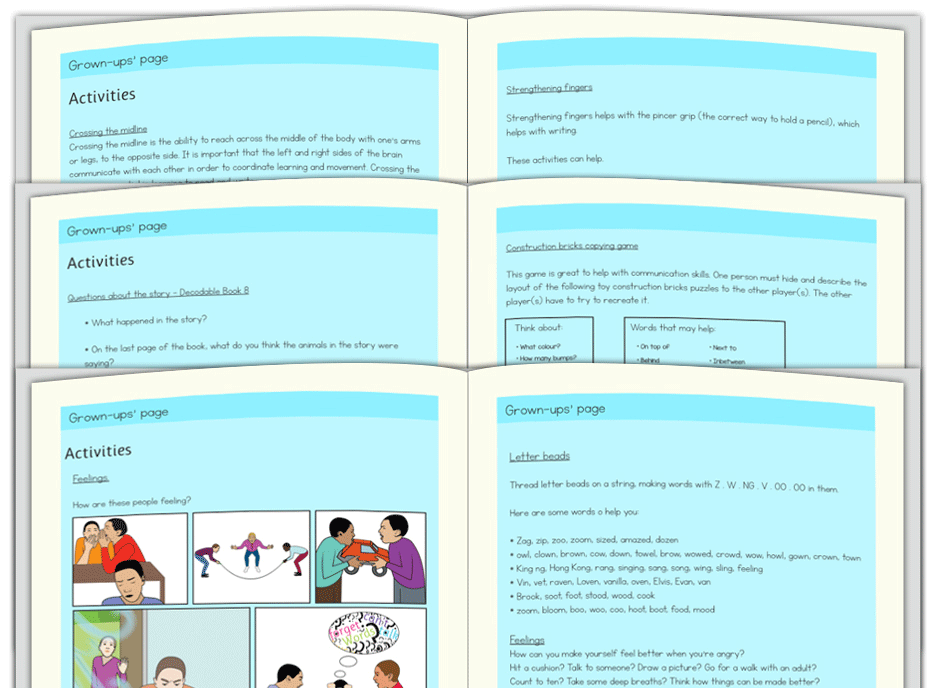This all began when my son couldn’t understand any of the current systems of teaching phonics, and I just knew he needed more of a visual–sound link to teach him the shape of a letter and at the same time the sound each letter made. My son got this technique really quickly and he learnt to read! I began trying it out on other children, with and without special needs, and it was a fantastic success. And so Clever Phonics was born!
There are three main types of books: Phonics Books, Decodable Books and Workbooks.

Each Phonics Book has six sounds in. Each sound has a unique visual–sound link.
What’s the visual–sound link?
For example, here you can see, for the sound ‘a’, a patient showing the dentist their teeth and saying ‘aaa’ (as in the sound you make when you say the beginning of the word ‘apple’ ) Then you see a close-up of the mouth and the person’s finger, which mimics the shape of the letter ‘a’ and creates a visual–sound link.

As well as the unique visual–sound link, each sound has a song and an action.

At the end of each of these books is a recap, first with a visual clue, then without. Both lower-case and upper-case letters are included.
The children can earn a sticker at each stage.
We highly recommend these colourful star stickers from our friends at Innoveem. Click here for more details.


Decodable Books ONLY use the letters and sounds the children have learned in the corresponding Phonics Book. Here they start to learn to blend these sounds together to start to read. Letter cards are included in every Decodable Book to help with blending. The illustrations have been designed to help with reading the story.


In each Workbooks the children will have an opportunity to:
Click here for a full list of activities in the workbooks.
Our unique activities in the back of the Workbooks can help to flag up any potential challenges that children may need extra help with.

The activities are based on:
All the Clever Phonics books have a yellowy cream background to reduce white glare and help with contrast. The font used was originally from ‘opendyslexic’ and has been amended after extensive research to enable people with dyslexia to access our books. In this font, each letter is heavier at the bottom, so for people with dyslexia, the letters are less likely to move around.

Below is our cursive writing.

There are 82 books in the Clever Phonics series. The sounds covered are:
1. s•a•t•i•p•n
2. c k•e•h•r•m•d
3. g•o•u•l•f•b
4. ai•j•oa•ie•al•ur•ee•or
5. z•w•aw•ow•ir•ng•v•oo•oo•ow2
6. y•x•ay•oy•ch•sh•ew•th•th
7. qu•ou•oi•ue•air•er•ar
8. igh•ear•ure
9. ‘ed’ /d/ • ‘ed’ /t/ • ‘ae’ /ai/ • ‘ue’ /yoo/ • ‘tu’ /ch/
10. ‘a_e’ /ai/ • ‘e_e’ /ee/ • ‘i_e’ /ie/ • ‘oe’ /oa/ • ‘o_e’ /oe/• ‘u_e’ /yoo/
11. ‘-le’ /l/ • ‘ea’ /ee/ • ‘ea’ /e/ ‘ph’ /f/ • ‘wh’ /w/• ‘y’ /ee/
12. ‘y’ /ie/ • ‘y’ /i/ • ‘a’ /ai/ • ‘e’ /ee/ ‘i’ /ie/ • ‘o’ /oa/ • ‘u’ /yoo/
13. ‘c’ and ‘ce’ /s/• ‘g’, ‘ge’ and ‘dge’ /j/ • ‘ey’ /ee/ • ‘u’ /short oo/• ‘ie’ /ee/ • ‘a’ /o/
14. ‘au’ /or/ • ‘ch’ /k/ • ‘u_e’ /long oo/ ‘ch’, ‘ti’, ‘ci’ and ‘ssi’ /sh/ • ‘s’, ‘se’ and ‘ze’ /z/ ‘oar’, ‘oor’, ‘ore’ and ‘our’ /or/ • ‘se’, ‘sc’ and ‘st’ /s/
15. ‘gh’ /f/ • ‘kn’, ‘gn’ and ‘ne’ /n/ ‘o’ and ‘ou’ /u/ ‘si’, ‘s’, ‘z’ and ‘ge’ /zh/ ‘ve’ /v/ • ‘a’ and ‘al’ /ar/
16. ‘me’, ‘mb’, ‘mn’ /m/ • ‘eer’, ‘ere’, ‘ier’ /ear/ ‘rh’, ‘wr’ /r/ • ‘gu’, ‘gh’, ‘gue’ /g/ ‘are’, ‘ear’, ‘ere’ /air/ • ‘ey’, ‘eigh’, ‘ea’, ‘aigh’ /ai/ ‘ough’ /oa/
17. ‘ar’, ‘al’, ‘augh’ and ‘ough’ /or/ • ‘kes’ /ks/ ‘ou’ and ‘ui’ /long oo/ • ‘ue’, ‘ew’ and ‘eau’ / yoo/ ‘ear’ and ‘or’ /er/ • ‘u’ /w/
18. ‘o’ /long oo/ • ‘qu’ and ‘que’ /k/ • ‘ou’ and ‘eau’ /oa/ ‘ei’ /ie/ • ‘ough’ /ow/
19. ‘i’ /ee/ • ‘bu’ /b/ • ‘o’, ‘ou’ and ‘oul’ /short oo/ ‘u’ /long oo/